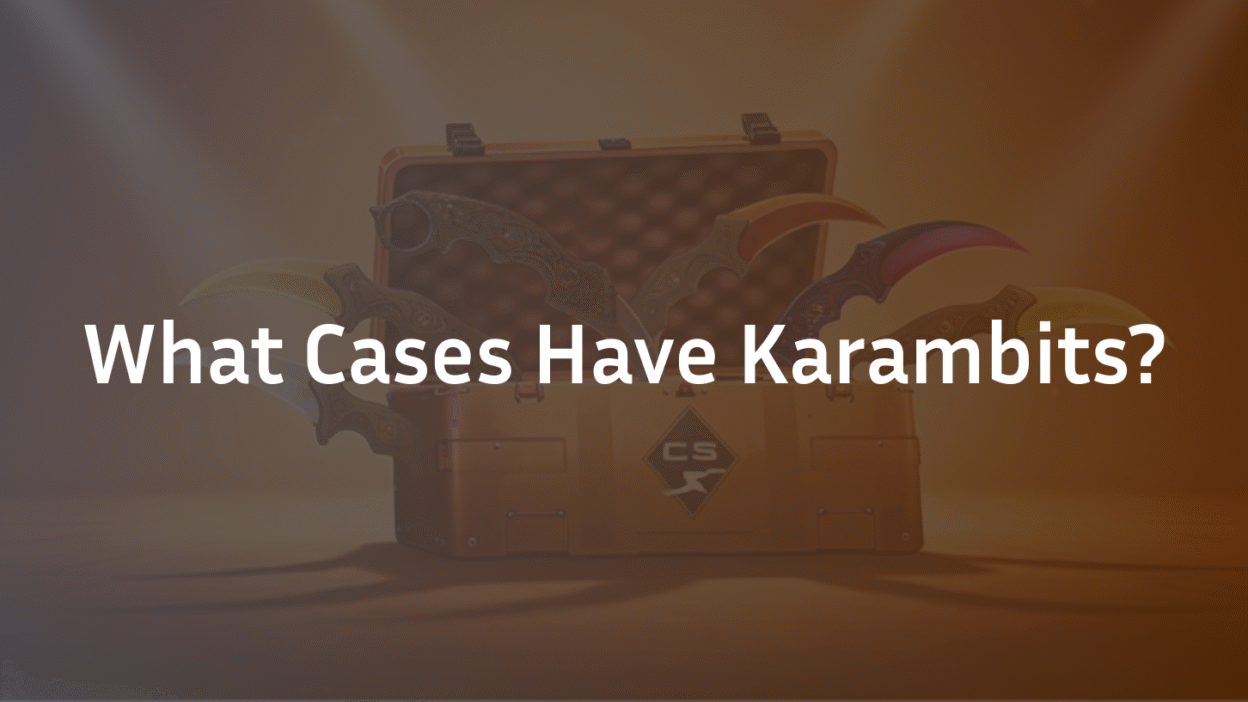The curved blade of the Karambit is the ultimate status symbol in Counter-Strike 2. For many players, unboxing one is a dream goal. But with so many cases in the game, which ones actually hold this legendary knife?
This guide does more than just list the cases. We’ll break down the real odds of unboxing one, reveal a strategic alternative to pure luck, and explain what to do if you finally get one.
The Karambit: CS2’s Most Coveted Knife
The karambit isn’t just another melee weapon in Counter-Strike 2; it’s a status symbol. With its distinctive curved blade inspired by Southeast Asian farming tools, the karambit stands out from every other knife in the game. Its popularity isn’t just about looks—it’s a combination of a unique design, a fluid animation, and a prestige that signals a dedicated or fortunate player.
For many, unboxing a karambit is the ultimate CS2 achievement. But before we dive into the specific cases that contain this prized knife, it’s crucial to understand why it holds such a legendary status in the community.
The Unique Karambit Inspect Animation
While most knives are simply pulled out and waved around, the karambit’s inspect animation is a performance. Your character effortlessly flips the knife in a continuous, circular motion around their fingers. This smooth, hypnotic display is a key reason for its desirability. It’s a flashy, satisfying animation that never gets old, making it a constant visual reward for its owner. If you want to master showing off your skins, our complete CS2 inspect guide covers all the tricks.
What Makes a Karambit Valuable?
Several factors combine to create the karambit’s high price tag and coveted status:
- Rarity: As a Covert-grade knife, it has the lowest drop rate from cases.
- Demand: Its iconic look and animation make it the most sought-after knife type for many players.
- Skin Finish: The specific paint job (like Fade, Doppler, or Case Hardened) drastically affects value.
- Float Value: The wear and tear on the skin, known as its understanding CS2 float values, can make a common skin rare or a rare skin worthless.
Understanding this context is key. You’re not just chasing any knife; you’re chasing the pinnacle of CS2 cosmetic items. Now, let’s pull back the curtain on the first thing you need to know: the staggering odds you’re up against.
The Hard Truth: Understanding CS2 Case Odds
Chasing a karambit through case unboxing is a high-stakes gamble, and understanding the brutal mathematics behind CS2 case odds is essential. The excitement of the unboxing animation often overshadows a simple, cold fact: the system is explicitly designed to be a net loss for the vast majority of players.
Valve has publicly disclosed the odds for the “Rare Special Item” pool, which includes all knives and gloves. This transparency reveals just how steep the climb is.
The Reality of Covert Knife Drop Rates
When you open a case, you’re rolling a virtual dice with heavily weighted outcomes. Here’s the typical breakdown of CS2 knife odds:
- Mil-Spec (Blue): ~79.92% Chance
- Restricted (Purple): ~15.98% Chance
- Classified (Pink): ~3.20% Chance
- Covert (Red): ~0.64% Chance
- Rare Special Item (Yellow – Knives/Gloves): ~0.26% Chance
That miniscule 0.26% is your chance to get any knife or glove from the case’s specific collection. If you hit that roll, you then face another set of odds to land the specific knife type and skin you want. The chance of unboxing a specific karambit, like a Doppler or a Fade, is a fraction of that already tiny percentage. For a deeper dive into these numbers, our dedicated guide on CS2 knife odds and drop rates breaks it down further.
Cost-Benefit Analysis: Unboxing vs. Buying
Let’s put this into a practical perspective. If a case key costs $2.50 and you have a 0.26% chance to get a knife, you’d statistically need to open about 385 cases to expect one knife drop. That’s an investment of approximately $962.50 for a single knife, which could be a low-tier model worth $100 or a high-tier karambit worth thousands.
Now, compare that to the Steam Community Market. You can directly purchase a specific karambit skin for a fixed, known price. While the upfront cost is high, it’s a guaranteed transaction. Unboxing is paying for a chance; buying is paying for a certainty.
Knowing the odds is the first step. The next is knowing exactly where to look. Let’s move from the abstract probabilities to the concrete list of every case that can actually hold your future karambit.
Complete List of All Cases with Karambits
Now for the list you came for. Karambits are not found in every case; they are exclusive to specific collections introduced after their initial release. These cases are split into two main categories: those that are still part of the active drop pool and those that have been retired to the “CS2 Vault.”
Understanding this distinction is critical. You can only receive active drop cases randomly after matches, but you can still open any case, active or vaulted, if you purchase it from the Steam Community Market.
Active Drop Cases (You Can Get Now)
These cases can drop for you at the end of a CS2 match. Their contents, including the potential for a karambit, are still obtainable through random drops.
| Case Name | Notable Karambit Skins Available |
|---|---|
| Chroma 3 Case | Gamma Doppler, Bright Water, Freehand, Ultraviolet |
| Gamma 2 Case | Gamma Doppler (Phase 1-4), Lore, Black Laminate |
| Spectrum 2 Case | Doppler (Phase 1-4), Marble Fade, Tiger Tooth, Rust Coat |
| Clutch Case | Doppler (Phase 1-4), Freehand, Black Laminate, Bright Water |
| Prisma 2 Case | Doppler (Phase 1-4), Ultraviolet, Tiger Tooth, Rust Coat |
The CS2 Vault (Discontinued & Rare Cases)
These cases no longer drop randomly after matches. However, they still exist in players’ inventories and can be traded or purchased on the market. Opening them is the only way to get their specific, often highly sought-after, karambit finishes.
| Case Name | Notable Karambit Skins Available |
|---|---|
| Chroma Case | Fade, Slaughter, Case Hardened, Crimson Web, Night |
| Chroma 2 Case | Doppler (Phase 1-4), Marble Fade, Tiger Tooth, Rust Coat |
| Gamma Case | Gamma Doppler (Phase 1-4), Lore, Black Laminate, Bright Water |
| Spectrum Case | Doppler (Phase 1-4), Marble Fade, Tiger Tooth, Rust Coat, Black Laminate |
| Operation Breakout Weapon Case | The original case that introduced the karambit, featuring Fade, Slaughter, and Night skins. |
With this complete list in hand, the next logical question is: which one should you actually open? The answer isn’t the same for everyone, and it depends entirely on your goals and budget.
How to Choose the Right Case for You
With a long list of potential cases, choosing the right one to open can feel overwhelming. The “best” case isn’t a single answer—it depends entirely on your goals and budget. Are you looking for the most economical chance at any karambit, or are you dreaming of unboxing a truly legendary skin? Let’s break down the strategy.
Best Case for Budget-Conscious Openers
If you’re working with a limited budget but still want a shot at a karambit, your best bet is to focus on cases with a lower purchase price. Since the key cost is fixed, a cheaper case means a lower total investment per unboxing attempt.
- Top Pick: Clutch Case – This case often has one of the lowest market prices among cases that contain karambits, making it the most cost-effective entry point.
- Strategy: The goal here is to minimize upfront cost per spin of the wheel. You’re sacrificing the chance at the absolute highest-tier karambit finishes for more attempts at the rarity roll itself.
Best Case for Chasing High-Tier Skins
If budget is less of a concern and you’re aiming for the rarest, most valuable karambits, you need to target cases with the most desirable skin finishes.
- Top Pick: Spectrum Case – This vaulted case is a treasure trove of high-value finishes. It contains the coveted Doppler (including Sapphire, Ruby, and Black Pearl), Marble Fade, and Tiger Tooth karambits, some of which rank among the most expensive CS2 knives.
- Strategy: While the case itself is more expensive, the potential payoff is far greater. You’re paying a premium for a ticket to the highest-stakes lottery.
| Goal | Recommended Case | Why It’s a Good Choice | Potential Drawback |
|---|---|---|---|
| Lowest Cost per Open | Clutch Case | Low case price maximizes number of unboxing attempts. | Lower potential value on average; fewer “god tier” skins. |
| Chasing High-Tier Skins | Spectrum Case | Contains the most sought-after finishes like Sapphire/Ruby. | High case price and even steeper overall cost for long odds. |
| Balanced Approach | Prisma 2 Case | Active drop, so case is relatively affordable, with solid skin options. | Still a gamble, but a more moderate one. |
Choosing a case is the pure gamble. But what if there was a more strategic, calculated way to work towards your dream karambit? There is, and it involves mastering the game’s crafting system.
The Smart Path: Karambit Trade-Up Contracts
If the lottery-like odds of case unboxing make you hesitant, there’s a more strategic approach: the trade-up contract. This crafting system allows you to trade multiple lower-tier skins for a single, higher-tier one from the same collection. While still involving risk and investment, it offers more control and predictability than blindly opening cases.
Think of it as crafting your own chance at a karambit rather than hoping for random luck.
How a Trade-Up Contract Works
The trade-up system follows specific, consistent rules:
- Input: You select 10 skins of the same rarity from a single collection.
- Output: You receive 1 skin of the next highest rarity from that same collection.
- The Float Factor: The “wear” (float value) of your output skin is a weighted average of the 10 input skins. This means using lower-float (Factory New) inputs increases your chance of a lower-float output.
For example, to target a Covert-grade karambit, you would need to use 10 Classified (Pink) skins from a collection that contains both those pinks and the karambit you want as a Covert outcome.
Building a Profitable Karambit Trade-Up
This is where strategy overtakes pure chance. A successful karambit trade-up requires careful planning.
- Step 1: Choose Your Target. Identify which karambit skin and from which collection you want to pursue (e.g., a Gamma Doppler from the Gamma 2 Case).
- Step 2: Source Your Inputs. Acquire 10 Classified skins from that exact collection. The cost of these skins is your total investment.
- Step 3: Calculate the Odds. Not all Classified skins in a collection lead to a knife. Some lead to gloves or other Covert weapons. You must calculate the percentage chance of actually hitting the karambit. This is where a CS2 trade-up calculator becomes an essential tool, allowing you to simulate the contract and see your exact odds and potential outcomes.
- Step 4: Execute. If the potential reward justifies the cost and risk, execute the contract.
This method turns the pursuit from a pure gamble into a calculated investment. But what happens if your calculated risk—or a random unboxing—actually pays off? The journey isn’t over once the karambit is in your inventory.
After the Unbox: What to Do with Your Karambit
The moment has arrived. You’ve beaten the odds, either through a lucky unbox or a smart trade-up, and a karambit is now sitting in your inventory. The excitement is real, but your journey isn’t over. What you do next can protect your investment and maximize your enjoyment.
Inspecting and Showing Off Your Skin
First things first, take a moment to appreciate your new prize. Open a practice server and use the +use command (default key ‘F’) to enjoy the signature karambit spin. This is the moment you’ve been working towards. Pay close attention to the details of your specific skin—the pattern of a Case Hardened, the fade percentage of a Fade, or the phase of a Doppler. These details are what give your knife its unique character and value.
Insuring and Trading Your Karambit
A karambit is a significant financial asset. Treat it like one.
- Secure Your Account: Ensure you have Steam Guard Mobile Authenticator enabled. This adds a crucial layer of security, preventing unauthorized trades and making any trade holds much shorter. Without it, your account is a prime target for thieves.
- Understand Trade Holds: If you didn’t purchase the knife directly from the market, be aware that any trade or sale will likely be subject to a 15-day trade hold if your Steam Guard is not fully set up or has been recently changed.
- Consider the Market: The value of CS2 skins can fluctuate. You might decide to hold onto your karambit as a long-term investment, use it as a play skin, or even trade it for a different knife or multiple items. If you’re considering its worth, check the current listings for similar wear and pattern on the Steam Community Market to stay informed.
Whether you secured your karambit through luck, strategy, or a direct purchase, you likely still have some questions. Let’s address the most common ones head-on in our final FAQ section.
Frequently Asked Questions (FAQ)
What is the best case to open for a karambit?
There’s no single “best” case, as it depends on your goal. For the lowest cost per open, the Clutch Case is a good choice. For chasing the most valuable high-tier skins like Sapphires and Rubies, the Spectrum Case is typically your best target.
Can you still get karambits from old cases?
Yes, but only if you purchase the old, vaulted cases from the Steam Community Market or through trading. These cases no longer drop randomly after matches, but they can still be opened with purchased keys.
What are the odds of unboxing a karambit?
The chance of unboxing any knife or gloves from a case is approximately 0.26%. The odds of getting a specific karambit are even lower, as you must first hit that 0.26% and then land on the exact knife type and skin you want from the available pool.
What is the rarest karambit skin?
The rarest karambits are generally the “Gem” finishes—Sapphire, Ruby, and Black Pearl—in the Doppler family. Their rarity is further amplified by a pristine float value and, for Case Hardened skins, a desirable “Blue Gem” pattern.
How much does a karambit cost?
Prices vary wildly based on the skin and wear. A common karambit like a Forest DDPAT might start around a few hundred dollars, while a pristine StatTrak™ Karambit Doppler Sapphire can sell for over $20,000 on the market.
What is a Karambit Fade?
The Fade is a highly sought-after finish where the blade features a gradient from yellow to pink to purple. The percentage of pink/purple (the “fade percentage”) determines its rarity and value, with 100% fades being the most desirable.
What case is the Karambit Doppler in?
The Karambit Doppler can be found in several cases, including the Chroma 2 Case, Spectrum Case, Spectrum 2 Case, Clutch Case, and Prisma 2 Case.
Is it cheaper to unbox or buy a karambit?
Statistically, it is almost always cheaper to buy the karambit you want directly from the market. Unboxing is a form of gambling where the house (Valve) always has a significant edge. You pay for chance; buying pays for certainty.
Can you get a free karambit?
It is virtually impossible to get a karambit for free through legitimate means. The only theoretical “free” method would be to receive one as an extremely rare drop after a match, but the odds are astronomically low. Be very wary of any website or person claiming to give away free karambits, as these are almost always scams.
What is a Karambit Case Hardened Blue Gem?
This refers to a Karambit with the Case Hardened finish that has an unusually high percentage of blue on the blade. These specific patterns are exceptionally rare and can be worth many times more than a standard Case Hardened karambit due to their unique and desirable appearance.
Of course. Here are 10 additional FAQs to make the guide even more comprehensive, inserted logically into the existing FAQ section.
Frequently Asked Questions (FAQ)
What is the best case to open for a karambit?
There’s no single “best” case, as it depends on your goal. For the lowest cost per open, the Clutch Case is a good choice. For chasing the most valuable high-tier skins like Sapphires and Rubies, the Spectrum Case is typically your best target.
Can you still get karambits from old cases?
Yes, but only if you purchase the old, vaulted cases from the Steam Community Market or through trading. These cases no longer drop randomly after matches, but they can still be opened with purchased keys.
What are the odds of unboxing a karambit?
The chance of unboxing any knife or gloves from a case is approximately 0.26%. The odds of getting a specific karambit are even lower, as you must first hit that 0.26% and then land on the exact knife type and skin you want from the available pool.
What is the rarest karambit skin?
The rarest karambits are generally the “Gem” finishes—Sapphire, Ruby, and Black Pearl—in the Doppler family. Their rarity is further amplified by a pristine float value and, for Case Hardened skins, a desirable “Blue Gem” pattern.
How much does a karambit cost?
Prices vary wildly based on the skin and wear. A common karambit like a Forest DDPAT might start around a few hundred dollars, while a pristine StatTrak™ Karambit Doppler Sapphire can sell for over $20,000 on the market.
What is a Karambit Fade?
The Fade is a highly sought-after finish where the blade features a gradient from yellow to pink to purple. The percentage of pink/purple (the “fade percentage”) determines its rarity and value, with 100% fades being the most desirable.
What case is the Karambit Doppler in?
The Karambit Doppler can be found in several cases, including the Chroma 2 Case, Spectrum Case, Spectrum 2 Case, Clutch Case, and Prisma 2 Case.
Is it cheaper to unbox or buy a karambit?
Statistically, it is almost always cheaper to buy the karambit you want directly from the market. Unboxing is a form of gambling where the house (Valve) always has a significant edge. You pay for chance; buying pays for certainty.
Can you get a free karambit?
It is virtually impossible to get a karambit for free through legitimate means. The only theoretical “free” method would be to receive one as an extremely rare drop after a match, but the odds are astronomically low. Be very wary of any website or person claiming to give away free karambits, as these are almost always scams.
What is a Karambit Case Hardened Blue Gem?
This refers to a Karambit with the Case Hardened finish that has an unusually high percentage of blue on the blade. These specific patterns are exceptionally rare and can be worth many times more than a standard Case Hardened karambit due to their unique and desirable appearance.
Can you get a karambit from a trade-up contract?
Yes. This is a strategic method. By using 10 Classified (Pink) skins from a collection that includes a karambit as a Covert (Red) outcome, you can guarantee a Covert item, with a chance it will be the karambit. The exact odds depend on the collection.
What’s the difference between a Phase 1, 2, 3, 4, Sapphire, and Ruby Doppler?
Doppler karambits have different “phases” or color patterns. Phase 1-4 are black with varying amounts of green/blue. Sapphire is a solid, rare blue, Ruby is a solid, rare red, and Black Pearl is a rare black with speckles. The Sapphire, Ruby, and Black Pearl are vastly more rare and valuable.
Does the karambit have a gameplay advantage?
No. The karambit is a purely cosmetic item with the same range, damage, and attack speed as every other knife in CS2. Its advantage is psychological and aesthetic.
How many karambit skins are there?
There are dozens of karambit skins, with different combinations of finishes (e.g., Fade, Doppler, Tigertooth) and wear conditions (Factory New, Minimal Wear, etc.). New ones are occasionally added with new cases.
What karambit finish holds its value the best?
Iconic, high-tier finishes like Fade, Doppler Gems (Sapphire/Ruby), and Crimson Web (with a good float and large web pattern) tend to hold their value exceptionally well due to consistent, high demand.
Can you use a karambit in other Source games?
No. CS2 skins are exclusive to Counter-Strike 2 and cannot be transferred or used in other games like Team Fortress 2 or Half-Life: Alyx.
What is a “Stattrak” karambit?
Stattrak™ is a feature that tracks your lifetime kills with that specific weapon. A Stattrak karambit will have a digital counter on it that records your knife kills. These are typically more valuable than their non-Stattrak counterparts.
Is a karambit a good investment?
High-tier karambits from discontinued cases have historically appreciated in value, but like any market, it is volatile and not guaranteed. It should be considered a high-risk investment and primarily a luxury cosmetic item.
How do I change my knife to be held in the left hand?
You can use the console command cl_righthand 0 to make your viewmodel left-handed, which will also show your karambit in the left hand. For a persistent change, you can add it to your CS2 autoexec config file.
What does “FN” or “MW” mean for a karambit?
These are wear tiers. FN (Factory New) is the best condition with minimal wear, followed by MW (Minimal Wear), FT (Field-Tested), WW (Well-Worn), and BS (Battle-Scarred). Lower wear typically commands a higher price.



